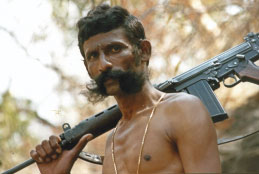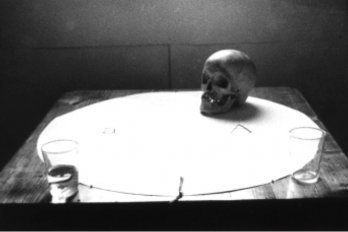
madurai—As soon as he was strong enough to lift a rifle, Veerappan began bringing down prey. He learned to hunt with his father, but quickly surpassed him, becoming the youngest boy in his village in India to kill a tiger. At twelve, he felled his first elephant. Police arrested him days later, but he escaped. The bounty for the ivory, which was more than his father could make in a year, whetted his appetite.
Over the next two decades, Veerappan would poach hundreds of tuskers in his native forest. When the herds thinned, he moved on to the massive trees that had sheltered them, culling sandalwood, called “brown gold” for the high prices it fetched as raw material for incense and perfume. As his profits grew, so did the police dragnet marshalled to catch him, but the more men hunted him, the more invincible he became. He choreographed deadly attacks on police and rival criminals alike, often improvising daring escapes.
These are the stories—some real, some imagined—that made Koose Muniswamy Veerappan a legend. On the streets of Bangalore and Chennai, and in the kitsch stands of bus stations across India, posters of the “forest bandit”—expression defiant, rifle slung over his shoulder, moustache jutting out beyond the confines of his chiselled face—hung alongside images of Gandhi, Nehru, and technicolour Hindu gods.
Last year, on the morning of October 19, 2004, I stumbled upon a broadcast announcing that Veerappan had been killed. It flickered across the eight-inch screen at the roadside stall where I stopped every morning for chai in Madurai, a city of about 1 million people in Tamil Nadu, India’s southeasternmost state. Shoulder to shoulder with rickshaw drivers and street cleaners, I watched as Chief K. Vijaykumar, head of the Special Task Force (stf) that had spent the last twelve years trying to catch Veerappan and his gang, accounted for the bloodshed the night before.
As Chief Vijaykumar told it, an undercover officer picked up the outlaws in a van disguised as an ambulance, then drove to a pre-established location where thirty-five officers lay in wait. The mole slammed on the brakes, yanked the keys from the ignition, and ran for cover. Veerappan’s gang was warned twice to surrender, but instead opened fire from inside the vehicle. The shootout lasted twenty minutes; when it was over, all four outlaws lay dead in the van, with not a single officer wounded.
State politicians and the press applauded the stf’s triumph. Within hours of the encounter, Chief Minister Selvi Jayalalithaa had released a statement offering her own account of the shootout (one of several different versions that would soon appear). The next day, she promised to reward the officers for their “tremendous feat of valour.” The Indian media followed her lead, embracing Chief Vijaykumar with the kind of idolatry it had once reserved for the forest bandit. “Hero!” read the headline of a major Tamil weekly, beneath a photo of the chief crouched in a furtive pose, his handgun gleaming.
To some in Tamil Nadu, the chief was no hero, however. During the decade before Veerappan was killed, human-rights groups had accused stf officers of more than 1,000 atrocities, including torture, rape, and murder, as they pursued justice in the states of Tamil Nadu and Karnataka. I had met a few of the victims the week before Veerappan’s death, while working as a human-rights researcher. We sat in the shade of an acacia tree near a torture-rehabilitation centre not far from where the ambush would take place, as women in bright pink and indigo saris shared their stories.
“Semala” was one of the last victims to speak. In 1993, she and her husband were living in the forests where Veerappan operated. One night, they came home to find stf officers waiting for them. They were accused of collaborating with the gang, then taken to an interrogation camp known as “the workshop.” Semala’s account of the workshop was common to most of the testimonies I heard that day: “They rigged up [an] electric current to my private parts and [questioned] me in front of my husband. When I gave an answer they did not like, I was shocked.” After weeks at the workshop, Semala was sent to a state prison, where she was held without trial for seven years until human-rights defenders won her release. Her husband, whom the stf had kept behind at the torture facility, was never seen again.
At a time when most people in the area were reluctant to whisper Veerappan’s name for fear of stf reprisals, these women openly revered him. They believed his actions, however brutal, followed a code: he punished only those who got in his way. stf violence, by contrast, made victims of innocent people. (That the stf existed in part because of Veerappan didn’t seem to matter to them.) So horrific were the charges against the task force that in 1999, India’s National Human Rights Commission created a special panel to investigate. In December 2003, the panel passed its report on to the governments of Tamil Nadu and Karnataka for a final review. At the time I met with the torture victims, it had been repeatedly postponed.
A few weeks after that meeting, an audience gathered around the tiny TV at the chai stall to watch an ornate ceremony honouring 752 stf officers for their work catching Veerappan. On nearby stands, the Veerappan posters, long a fixture of the top racks, had vanished. It was nighttime, and spirals of steam rose from simmering milk vats as rice-cake vendors weaved between sweating torsos. We watched each officer receive an immediate promotion, land, and almost $8,500; Chief Vijaykumar shared $280,000 with a high-ranking colleague. As the theme from Star Wars played in the background, Chief Minister Jayalalithaa hung medals from the bowed necks of the officers to reward a job well done.


